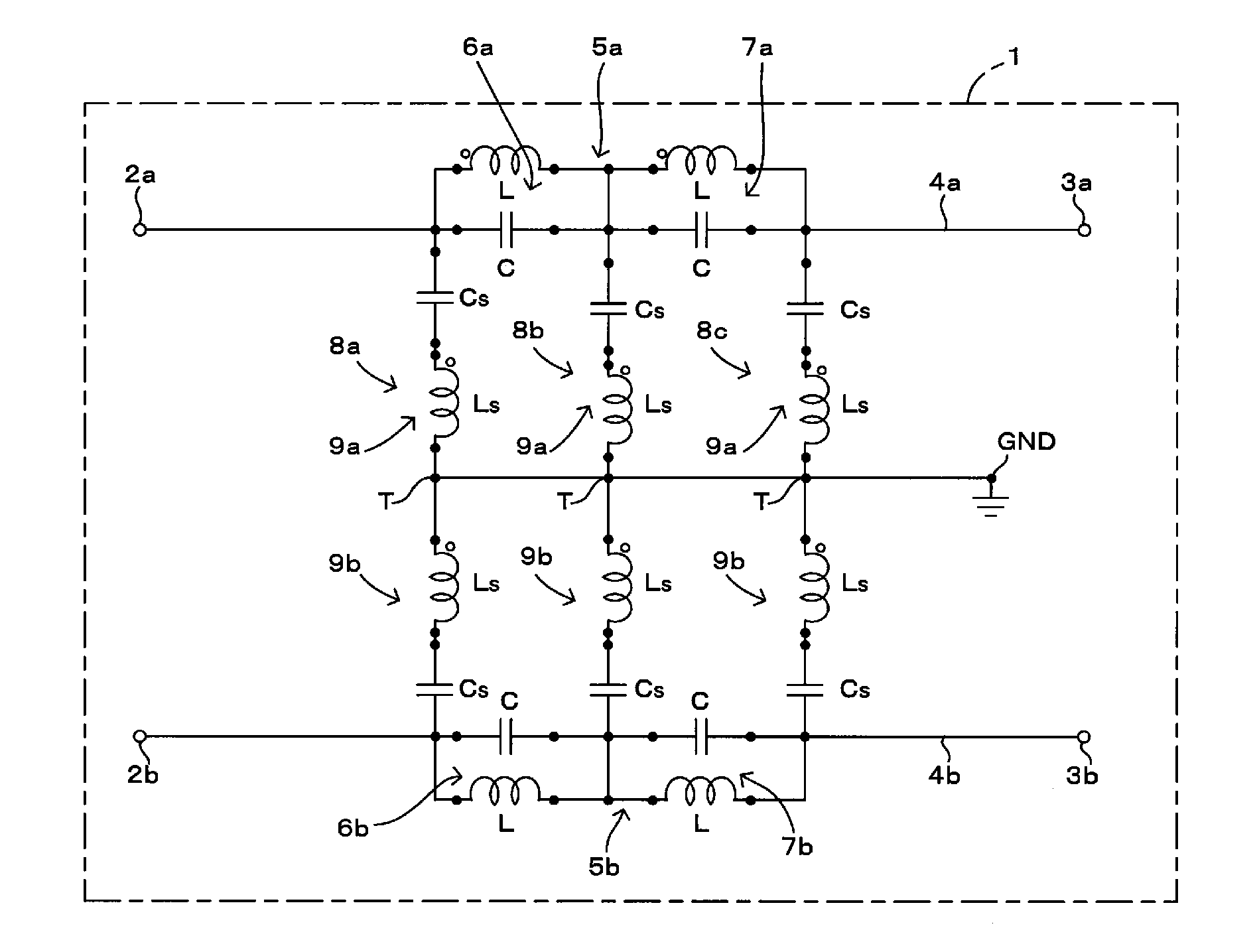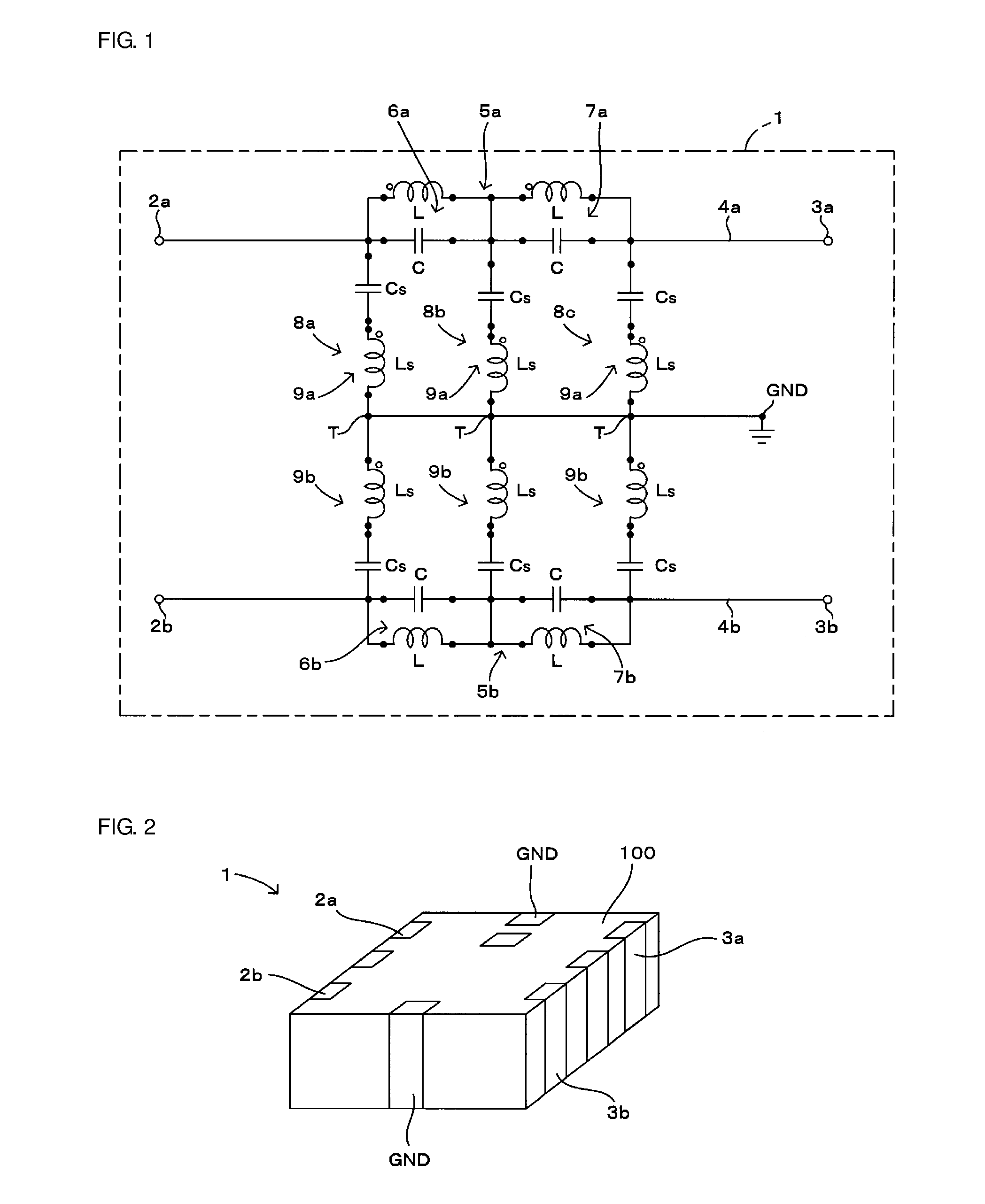Filter component
a filter component and filter technology, applied in the field of filter components, can solve the problems of insufficient attenuation of common mode noise and deterioration of attenuation characteristics of attenuating common mode noise of lc series resonance circuit, and achieve the effect of effectively attenuating common mode noise, widening the frequency range of attenuation characteristics, and less sharp resonance characteristics
- Summary
- Abstract
- Description
- Claims
- Application Information
AI Technical Summary
Benefits of technology
Problems solved by technology
Method used
Image
Examples
first preferred embodiment
[0051]A first preferred embodiment of the present invention will be described below with reference to FIGS. 1 through 4. FIG. 1 is a circuit diagram of a filter component according to the first preferred embodiment of the present invention. FIG. 2 is an external view of the filter component shown in FIG. 1. FIG. 3 is an enlarged view of the major portion of the internal portion of the filter component shown in FIG. 2. FIG. 4 is a graph illustrating frequency characteristics of the filter component shown in FIG. 1. In FIG. 3, among layers of a multilayer substrate included in the filter component shown in FIG. 2, only the lower layers of the multilayer substrate in which shunt circuits 8a, 8b, and 8c are disposed are shown.
[0052]An overview of the circuit configuration of a filter component 1 will be described below.
[0053]The filter component 1 shown in FIG. 1 has a function of eliminating common mode noise which propagates through differential lines. The filter component 1 includes ...
second preferred embodiment
[0077]A second preferred embodiment of the present invention will be described below with reference to FIGS. 7 and 8. FIG. 7 is a circuit diagram of a filter component according to the second preferred embodiment of the present invention. FIG. 8 is a graph illustrating frequency characteristics of the filter component shown in FIG. 7.
[0078]A filter component 1a of this preferred embodiment differs from the filter component 1 shown in FIG. 1 in the following points. As shown in FIG. 7, a shunt circuit 8 which connects the first line 4a and the second line 4b with each other is disposed only between the node between the LC parallel resonance circuits 6a and 7a on the first line 4a and the node between the LC parallel resonance circuits 6b and 7b on the second line 4b. The node T between the LC series resonance circuits 9a and 9b of the shunt circuit 8 is grounded via an inductor Lg (corresponding to “a third inductor”). The configurations of the other elements are similar to those of ...
third preferred embodiment
[0088]A third preferred embodiment of the present invention will be described below with reference to FIGS. 13 and 14. FIG. 13 is a circuit diagram of a filter component according to the third preferred embodiment of the present invention. FIG. 14 is a graph illustrating frequency characteristics of the filter component shown in FIG. 13.
[0089]A filter component 1b of this preferred embodiment differs from the filter component 1a shown in FIG. 7 in the following points. As shown in FIG. 13, in the first filter circuit 5a, a BEF is defined by a single LC parallel resonance circuit 6a, and in the second filter circuit 5b, a BEF is defined by a single LC parallel resonance circuit 6b. The shunt circuit 8 which connects the first line 4a and the second line 4b with each other is located between the previous stage of the LC parallel resonance circuit 6a and the previous stage of the LC parallel resonance circuit 6b. The configurations of the other elements are similar to those of the abov...
PUM
 Login to View More
Login to View More Abstract
Description
Claims
Application Information
 Login to View More
Login to View More - R&D
- Intellectual Property
- Life Sciences
- Materials
- Tech Scout
- Unparalleled Data Quality
- Higher Quality Content
- 60% Fewer Hallucinations
Browse by: Latest US Patents, China's latest patents, Technical Efficacy Thesaurus, Application Domain, Technology Topic, Popular Technical Reports.
© 2025 PatSnap. All rights reserved.Legal|Privacy policy|Modern Slavery Act Transparency Statement|Sitemap|About US| Contact US: help@patsnap.com



